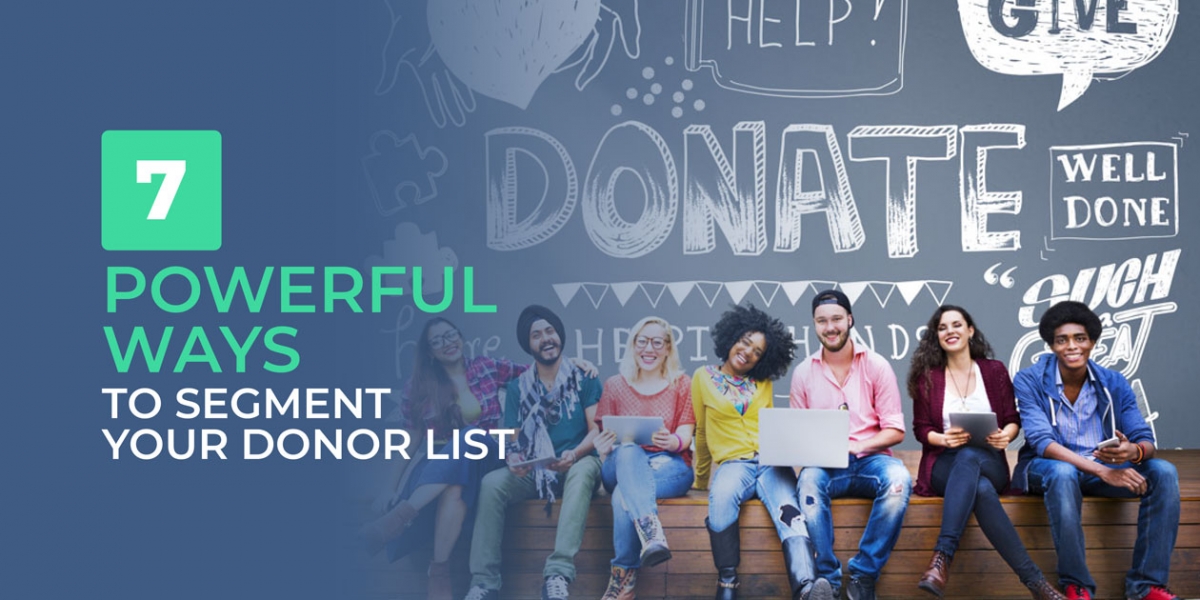As a nonprofit, your biggest asset is your relationship with the donors supporting your mission. Your next biggest asset is the data you collect on those donors.
Nonprofit fundraising is a practice of continuously improving practices to thrive with limited resources. Donor data, and how you manage it, is critical to creating long-term relationships with your donors to create impact.
But, this doesn’t mean raw data. Jumbled donor data will do little in helping you perfect your practices— it needs to be organized in a viewable, actionable manner. This is where segmentation enters into the picture.
Segmenting your donor data allows you to use more targeted messaging that will motivate your community to act. From nurturing your email list, to inspiring the start of major donor stewardship conversations, segmentation can affect your success in scaling your organization’s impact.
We’re going to examine segmenting your donor list through the following points:
- How do you segment your donors?
What are some powerful ways to segment your donor list?
- Type of donor.
- Engagement level and method.
- Preferred communication method.
- Motivation or topic interest.
- Age and demographic.
- Giving capacity.
We’re going to begin by exploring the basics of segmentation, including the online donation tools and other software that can help guide your efforts. Then, we’re going to explore seven segmentation strategies that can help improve the responses to your donor outreach. Let’s get started!

What does it mean to segment your donors?
Donor segmentation is the process through which nonprofits organize their donor list into groupings of common characteristics. This allows organizations to target their communications to the groupings with messaging that drives engagement, saving time and human resources while increasing success.
Further, segmentation is a powerful tool in prospect research. It can reveal valuable insights that might not be as obvious when examining your donor base as a whole. From identifying opportunities for major gifts to discovering supporters who might be interested in beginning the planned giving process, applying segmentation practices to your donor data is worthwhile.
How do you segment your donors?
When you segment your donor list, you take the raw donor data and organize it into more useful groupings around characteristics that all those individuals share. Even if you’re not a data expert, there are a few tools that can help guide your efforts.
Your online giving platform, CMS, volunteer management tool, and social networks can all gather data on your donor interactions. Ensure all of these tools integrate with your nonprofit’s CRM solution whenever possible, so all of the data collected can flow seamlessly into your central database system. This gives you easier access to the full picture of your data, and most CRM platforms include robust segmentation, filtering, and sorting functions to help you get started.
From there, follow a few best practices when segmenting your donors:
- Start by building donor personas through stakeholder interviews or surveys.
- Assign meaningful segments to those audiences. Don’t just assign groupings for every trend you notice but instead corresponding to your nonprofit’s goals. For example, if you’re looking to engage younger supporters this year, create segments by generation.
- Maintain your donor database. This means regularly cleaning your data of any duplicates or out-of-date entries and creating uniform systems for data entry, ensuring you’re working with updated information at all times.
- Regularly revisit your segments to make sure they still represent your donor base and your nonprofit’s goals.
Once you’ve created your segments, it’s simply a matter of contacting donors through the correct marketing channel(s)! Let’s look at a few particularly helpful segments to consider.

What are some powerful ways to segment your donor list?
Type of donor.
One of the easiest, most obvious segments to apply to your donor list is the type of donor. This includes first-time donors, recurring donors, major givers, etc.
For example, all of your first-time donors should be directed through a welcome series following their first instance of support. However, recurring donors should be approached in a way that reflects their history with your organization and in a more frequent manner.
Engagement history.
There are two legs of this segment— engagement level and engagement method.
Engagement level corresponds to how much a donor interacts with your nonprofit, such as someone who regularly communicates via social media versus someone who donated once via a peer-to-peer campaign and never returned. Engagement method refers to the ways a donor interacts with your nonprofit, such as acting as a volunteer versus never interacting in person and exclusively giving through your donation page.
There are many segments that can come from this category: highly engaged/loosely engaged, high communication frequency/low communication frequency, donor/volunteer/board member/social fundraiser, and even preferred giving method such as card/cash/check.
Preferred communication method.
Consider the preferred communication methods of your donors when segmenting your data. This will help you to contact them in the way they prefer, drastically increasing the chances they see your communications and respond accordingly.
Consider the following:
- How are supporters reaching your website? Organic traffic? Referral traffic?
- Which social media networks do your donors frequent?
- Are your donors smartphone-savvy, or maybe more responsive to text message giving methods?
- Have the majority of your donors opted into your email newsletter?
- Have you had much success with direct mail? Phone calls? In-person asks?
Contact the segments you create using the communication methods they’ve preferred in the past and you’ll have a higher response rate going forward.
Motivation or topic interest.
If you’re a nationwide organization collecting online donations from members across the country, you may be talking to donors that are motivated to work you’re doing in their region. Connect your message to that region specifically.
If you’re a nonprofit that works in several different issue area, try to tag your donors based on the issues that they have expressed the most interest in before.
This segment is less concrete than the others and might be harder to quantify with data points. Surveys and interviews will be great ways to begin your research.
Age and demographic.
There are major differences that pop up across generations, and it’s valuable to be cognizant of those when communicating with your donors.
For example, your youngest supporters may fall into Generation Z. This generation is hardly in its 20s yet, and contacting them with major or mid-level giving initiatives is going to fall on empty bank accounts. You’d be better off contacting them with peer-to-peer opportunities and volunteer programs.
However, targeting older segments with major giving, or planned giving, stewardship is likely to have much higher success overall. Your nonprofit needs supporters of all types, from volunteers to major supporters, and segmentation simply helps you market initiatives to those supporters most likely to fill each role.
Type of entity.
If your segments are singularly targeting individual donors, there’s a decent chance you’re missing out on segments of your support network.
Create segments for different supporting entities your nonprofit communicates with, including individual donors, corporate sponsors, other nonprofit partners, and grant-making foundations. From how you communicate to which opportunities you present, interacting with these various segments will be drastically different.
For example, your individual donor communications should be more personal and include smaller asks that one person could reasonably fulfill. Meanwhile, your corporate sponsors might be interested in contributing in a larger manner (such as sponsoring a whole event) and will probably want to receive something more substantial (like public recognition on your branded materials) in return.
Giving capacity.
Gifts of all sizes and types are greatly appreciated in nonprofit fundraising, from major capital campaign supporters to a smaller social fundraiser contribution. Your nonprofit is probably interacting with supporters at all levels, and it’s important that you’re completing outreach in a manner that doesn’t deter any of those various levels from giving.
For example, it’s important that you don’t scare off mid-level donors from giving by asking for donations that are simply way outside of their giving capacity. Similarly, avoid suggesting low gift amounts to major givers as that may lead to them giving less than originally planned, thinking you’re not in need of the larger gift.
Segment your donors by giving capacity to ensure your donation communications are targeted to the right demographic to achieve the most success.
Your donor data is your nonprofit’s most valuable tool to continue fundraising successfully in the future. Segmentation is the method of translating that data into actual next steps and successes.
Consider whether the above seven segmentation strategies will yield valuable insights for your nonprofit. If so, it’s time to start organizing your data! Even if you apply just a few of these strategies, you’ll be gleaning actionable information about your donors in no time.
After You’ve Segmented Your Audiences, What Next?
The next steps in the process is figure out what motivates donors within your segements and generate messaging that motivates them to act. Watch this video to learn more about getting started with a messaging strategy.
Guest Author: Andrew Berry
 Andrew is the head of marketing and customer success for Donately. After getting involved with nonprofits at a young age, he discovered a passion for helping the organizations that are making the world a better place. Knowing how vital online fundraising has become, his goal is to help nonprofits raise more money online each year! In his spare time, you will find him cooking up dinner, playing with his dog or cheering on Boston sports teams.
Andrew is the head of marketing and customer success for Donately. After getting involved with nonprofits at a young age, he discovered a passion for helping the organizations that are making the world a better place. Knowing how vital online fundraising has become, his goal is to help nonprofits raise more money online each year! In his spare time, you will find him cooking up dinner, playing with his dog or cheering on Boston sports teams.

